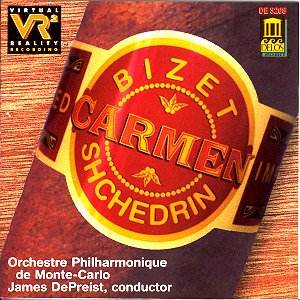Carmen has drawn arrangers and re-animators
like no other opera. A few prominent examples: the Broadway 'take' in
the form of the musical Carmen Jones (still drawing the crowds),
Franz Waxman's showcase Fantasy for violin (or trumpet) and orchestra
(or piano) and Shchedrin's supercharged ballet.
Shchedrin's music has both serious and playful facets;
rather like Malcolm Arnold's. I remember Vassili Sinaisky despatching
one of the Suites at Munich's Prinzregententheater in 1995 with such
mirthful delicacy that its humour actually prompted laughter among the
strait-laced audience. Such mastery buoys up the Carmen work which carries
the full title Carmen-Suite - Ballet Suite for strings and percussion
based on themes from 'Carmen' by Georges Bizet. It was written for
his wife, the prima ballerina, Maya Plisetskaya. It seems to have been
a vehicle for her own artistry. It formed a central component of the
USSR's cultural assault on the world in the decade after the Bay of
Pigs incident. The string section is big and is contrasted with a platoon
of five percussionists: one timpanist plus four others rushing around
from frame to frame. The themes come not exclusively from Carmen;
in Torero (tr.10) we are treated to the Slavonically apt, tense
yet quiet whistle of the Danse Bohémienne from La Jolie
Fille de Perth. Another import is the Farandole from L'Arlésienne.
This is Carmen in technicolour with the ears engaged by lushly
lit strings. The percussion are smokingly thunderous; usually earnest
but occasionally deliciously naive as in the Lionel Hampton vibraphone
episode in the Finale (tr.13). For plush Russian atmosphere try the
Adagio where Romeo and Juliet meets Carmen. Tchaikovsky
(Pathétique and 1812) and Prokofiev (Romeo and
Juliet) are twisted into the fabric where the motoric persona is
played by the percussion and where the melody is carried by the long-breathed
string lines.
This is a brilliant work that will please adventurous
newbies to the classical scene as well as balletophobes who are too
used to musically flimsy scores. Neophytes who strike out from here
towards other works by Shchedrin rather than to Bizet need to be very
selective and stick to the orchestral suites. They may well find other
works of his much harder going. Who knows, there may well be some who
will find their way to the Carmen opera via this suite. This
is garish and gaudy music and I love every minute of it and have done
ever since hearing the Melodiya Rozhdestvensky LP. We could perhaps
have done with a more vulgar and cavalier approach to the balance. This
is a work that responds to the spotlight. Any of the Russian performances
will deliver that bit extra but as a spot-on version of how the suite
might sound in the concert-hall this is ideal.
The traditional and unvarnished Carmen suite
might have seemed rather lack-lustre after the infusion of Shchedrin
accelerant. In fact it comes up dazzlingly here due to the return to
the scene of the woodwind and brass. DePreist and the Monégasque
orchestra give a very fine performance. They are enticingly recorded
as you can hear if you try the close chamber balance at tr. 16, the
Intermezzo (prelude to Act III). There is some outstandingly
accented oboe playing from the OPM-C principal.
For a CD set down in 1996, rather than an echo of a
1960s LP, this is rather short measure. Some more Shchedrin would have
been salutary but given the excellence of DePreist's pure Bizet, even
the other Carmen suite or one or both L'Arlésiennes
would have been a good idea.
Rob Barnett

